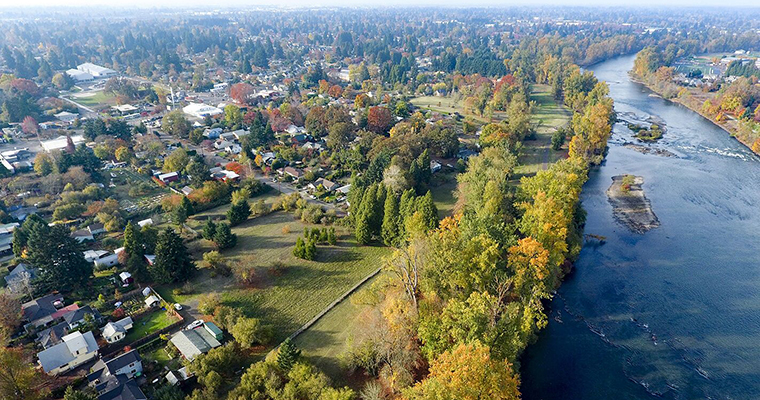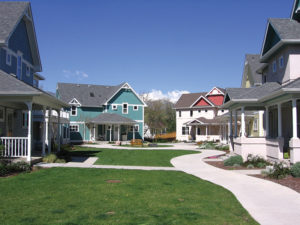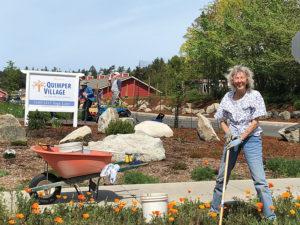By Karen Gimnig

River Song Cohousing
Resilient communities must adapt to change. The Cohousing Association of the United States, as a community of communities, is no different. Change is all around us and within us. The factors that lead to a successful cohousing movement, and even the definition of that success, are shifting and evolving. Change is opportunity and growth and vulnerability, lifeblood and danger, health and trauma, beautiful and inevitable and never-ending.
At CohoUS we are thinking a lot about change. We want to be conscious and transparent in the change that is coming and the ways we are engaging with it. Our focus is on the growth of the cohousing movement, the needs of our communities, both established and aspirational, and the ways in which cohousing can be an essential element in solving the problems the world faces today.
As a community of people passionate about the power of cohousing, we are aware of the need for change, know that it won’t be easy, and believe that together we can find solutions. As board member Ann Lehman says, “We know that living in cohousing enriches community life, and diminishes loneliness. The next 30 years is figuring out how to make it affordable!” Cohousing developer Jim Leach adds, “For the cohousing association to be wildly successful in these times it needs to offer an easily understood housing alternative that addresses the current crisis in housing cost in the urban markets where people want to live.”
Internally, we are finding that the diversity we’ve always sought is beginning to arrive. It brings new perspectives that are looking at cohousing as it is today and saying, “This does not work for us.” Early in the cohousing movement our primary objective was to spread the word about a little-known approach to housing. We were successful, as evidenced by articles in major publications, a new film, and multiple TED talks and podcasts, even if there is still incomplete understanding of what cohousing is. In short, we have taken the concept to the people, and many have heard it. The people most like “us” (current cohousers) are rejoicing and stepping up to build more cohousing. The people less like us, in race, in age, and particularly in financial resources, are saying, “What about me?” Many have heard our vision. They have read the statistics about loneliness, they have sought a place in community for themselves and their families, and they have not found homes they can afford. We want cohousing for all who want it.
A major barrier to “cohousing for all” is cost. Inflation in real estate prices has accelerated in recent years. The majority of cohousing is made up of market-rate homes with owners who expect that our homes will increase in value and build our wealth. This is reassuring security to those who can access it. To a lower–middle–class family it makes cohousing further and further out of reach.
There is a nationwide crisis in affordable housing and the factors that affect all housing impact cohousing in exactly the same way. Costs of new construction and home prices in general are climbing fast while relative wages fall. Seniors and young families (among others) find they can’t afford to live in cohousing. As the cohousing movement expands, external conditions are making it even harder than it has been before to include lower–priced homes in the neighborhoods we are developing.
The reality is that if we are going to make things different, we are going to have to do some things differently. Change will require looking, in part, to new ideas and approaches. It can be tricky to do this in a way that fully honors the work and the people that have gotten us this far; with a message of gratitude and appreciation for a foundation so strong that it can now support a whole new chapter in the movement, a new branch of growth not yet imagined.
The CohoUS staff and board of directors are really excited about what is coming for the cohousing movement in 2020 and beyond. This is what we see:

Belfast Cohousing and Ecovillage
We are a group of folks who care about building community and connection using the cohousing model. We began as an association of professionals with a common interest in cohousing. While we continue to rely on our professionals for wisdom, vision, and support, we have grown to be more. We see those who experience the benefits of cohousing becoming more engaged in the cohousing movement.
We are growing partnerships with other groups that share our values. As a community of communities our partnership is not only with those who want to build or live in cohousing, but also communities of people who grow connection through other models. We see connections with new allies.
We’re looking closely at our assumptions. We’re sorting the essential elements that define cohousing from the ideal traits that may not be possible for some communities. In particular, we are considering whether the social value of cohousing can be achieved while letting go of some architectural elements, home ownership, and development by future residents. We see lively discussions and blossoming ideas.
We’re considering ways to use existing housing stock. Approaches that make cohousing possible without new construction are particularly promising for reducing the money and time required to create cohousing.
● While clustered parking away from residences helps communities implement cohousing ideals, we wonder whether it might be possible to have cohousing in existing homes that have attached garages.
● A building in which all residents are members of a cohousing community is ideal, and we wonder whether a core group of cohousers within a building might enjoy the benefits of cohousing while gradually enticing the remaining residents to join them.
● The pedestrian walk is useful not for the concrete itself but for the relationships that form in that space. We wonder whether there are other ways to achieve those relationships. Perhaps the design elements that almost force us to hang out with each other (a good thing) could be replaced by less costly alternatives like social practices, other kinds of sharing, or even some new ideas in design.
We’re finding the parts of our foundation that remain essential as we grow.

Casa Verde Commons
● Intention remains key. “What differentiates cohousing from the other housing configurations is shared values, consensus decision making, and acceptance of others,” explains board president, Alan O’Hashi. People come together with a clear and actionable intention to know, support, and share with one another.
● We’re also holding tightly to proximity. Clustered homes on a single property foster community in a way that just doesn’t happen when you are spread across multiple acres, a town, or the country.
● It is private space that most distinguishes cohousing from other forms of intentional community. While we are considering where “coliving” with shared kitchens might fit to make cohousing more accessible, private homes remain a key element.
We are looking to grow more of what matters most in the communities we already have. Architect and board member Mary Kraus’ dream for cohousing is “that all existing communities will become more successful over the years―with more common meals, greater connection between neighbors, and a thriving culture of compassion. The more I live in cohousing,” she says, “The more I value the little connections―the ride given, the baking ingredient received, the smile shared on the pathway―and how deeply these bring us together.” We see established communities sharing their models for success.
We are focusing on affordability in our programming. We welcomed Eli Spivak’s tour of affordable cohousing at our national conference in Portland. Our first online conference, an Affordable Conference on Affordable Cohousing, happened on February 22.
We are identifying that we are a movement with impact far beyond housing. Loneliness is one of the most significant threats to health. Democracy desperately needs the collaborative skills learned when we practice consensus decision making. Work ranging from software development to community farming depends increasingly on the kind of teamwork experienced on community workdays and in the cooking of common meals. Our social fabric desperately needs the kinds of skills and experiences cohousing offers. Cohousing, like all intentional living, is a movement that makes the world a better place one community at a time and in expanding ripples across states and nations. We see ourselves as more than cohousers.
We at CohoUS are asking questions and exploring possibilities. 2020 begins a bright new decade for the cohousing movement. We have real challenges and we are looking forward to addressing them together. We are excited about the possibilities. We are clear that the experience of community is too important, too vital, and too essential in our world not to consider every barrier and find ways around it together.

Quimper Village
Karen Gimnig is the Communications Director for CohoUS, a nonprofit organization that educates and advocates for cohousing in the US. Your donation at cohousing.org will support their mission.
Excerpted from the Spring 2020 edition of Communities (#186), “Picking Up the Pieces: New Beginnings.”
